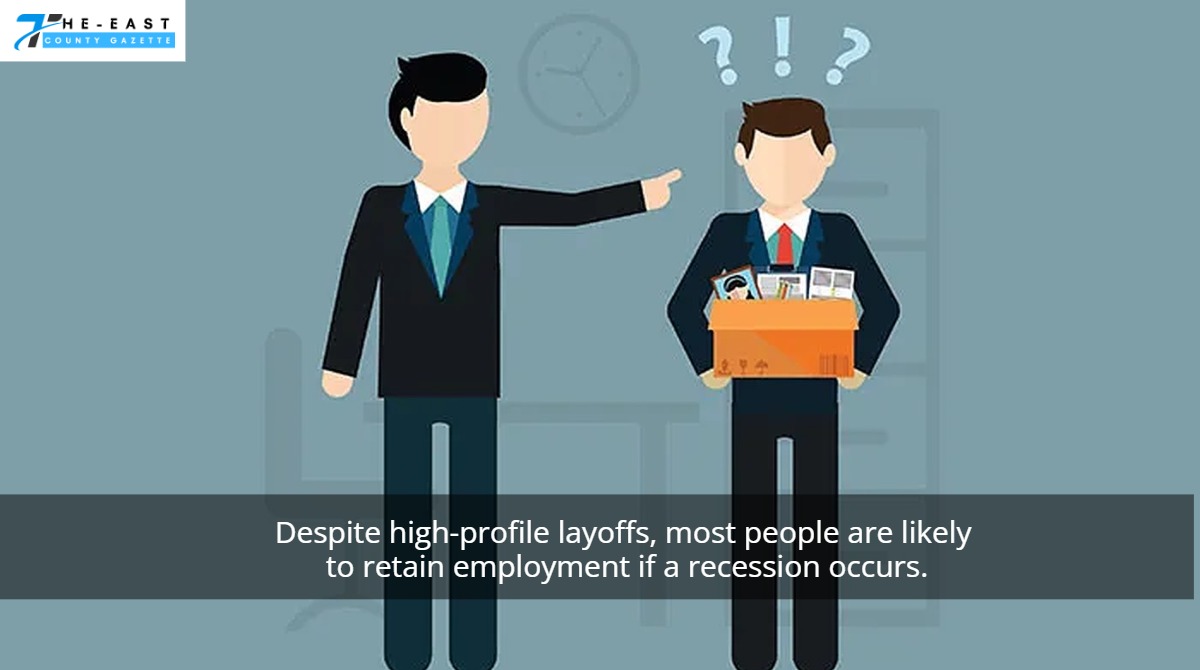The global economy is faltering, and some of the world’s largest corporations have already
laid off tens of thousands of workers. There is, however, a gleam of good news: this time
around, employees have a greater chance than usual of keeping their employment if a
recession occurs.
Nearly three years after the outbreak of COVID-19, businesses continue to complain that they cannot get the talent they need. They are concerned about labor shortages that would likely last past the epidemic and into the next recession. More profound influences, such as population shifts and immigration, are reducing their pool of available labor.

This indicates that despite deteriorating demand for their products and services, many
companies are aiming to keep or even increase their workforces rather than laying off
employees. They are stockpiling labor that they will need once the economy begins to
recover. Amazon and Goldman Sachs, among others, have recently released a number of
high-profile layoff notices.
However, they may be outliers. This would make the next economic downturn significantly different and, in some respects, less severe than those to which the world has been accustomed. By 2024, Bloomberg Economics predicts that the jobless rate in major nations will increase by around 3,3 million, a time in which most are anticipated to experience recessions.
Although there is a large number of jobs lost, it is far less than the 5.1 million jobs lost during the comparatively mild recession that started in 2001 and is dwarfed by the extent of the most recent worldwide recessions. In addition, the employment baseline is historically robust. According to the Organization for Economic Cooperation and Development, the unemployment rate in major industrialized nations was 4.4% in September, the lowest since the early 1980s.
White-collar sectors such as business services, technology, finance, and real estate, whose
personnel levels are much higher than pre-COVID-19 levels and where layoffs have already
started, may be more susceptible to layoffs this time around.
Jonas Prising, chief executive officer of the global hiring service ManpowerGroup,
anticipates that employers will attempt to retain personnel even if sales slow.
“They will keep their workforce despite a reduction in demand for their goods and services,” he argues. “They have no plans to hire. But I believe we can anticipate robust payrolls.”
At least in the United States, this is the message central bankers are receiving as they
attempt to curb sky-high inflation and demand in the economy and labor market without
triggering a recession. President of the Cleveland Federal Reserve Bank, Loretta Mester, said on November 10 that businesses are planning to retain employees despite the slowing economy since it has been so challenging to recruit and retain employees during the last several years. That would be advantageous in the sense that the unemployment rate would not need to increase as much.
Friday, the Fed will get its most recent assessment of the economy’s growth when the
government issues its November employment report. Bloomberg’s poll of economists
forecasts a gain of 200,000 jobs. In the United Kingdom, which, according to the majority of analysts and the government, is already in a recession, more than 500,000 jobs are expected to be lost over the next two years. However, doing so would only increase unemployment to 4.9%.
Even as the government’s budget watchdog released its cautionary estimate on November
16, business leaders in areas such as hospitality and retail were battling with labor
shortages.
Sharon White, head of the John Lewis Partnership, said, “It’s common knowledge that labor
shortages are forcing businesses to incur greater expenses.” I believe there is a much larger discourse about the labor market and employment, as well as how to bring individuals back into the workforce.
Regarding the euro region, unemployment has never been lower in the history of a single
currency. Despite the likelihood of a recession, official European Union projections issued at
the end of October indicate that employment growth would continue until 2024, although with a significant slowdown in 2023, and that unemployment will increase only mildly.
Officials attribute this to the government’s efforts to retain jobs, as well as the aging of
populations.
Possibly, better protection for European workers that restricts staff reductions by firms might also be beneficial. The world’s most significant public health crisis in a century has undoubtedly disturbed labor flows, causing nations like Australia to want to increase immigration. In the United States and the United Kingdom, labor market participation remains below pre-pandemic levels.
New Zealand is one of the affected economies. Adrian Orr, the governor of the central bank,
said that the labor shortage is all about labor, labor, and more labor.
Wednesday, after hiking interest rates by a record 75 basis points, Orr told reporters, “The
market is highly competitive.” “The turnover rate in the job market is astronomically high.
Huge rivalry exists on the market.”
In addition to claiming over 6 million deaths, the COVID-19 epidemic has left millions more
unable to work due to chronic COVID or other impairments. Additionally, many individuals
retire early, focus on their families, or advance their education.
As the massive baby boomer cohort retires and exits the workforce, a longer-term structural trend toward tighter employment markets has emerged.
According to a recent assessment of labor markets in the U.S., Canada, France, the U.K.,
Germany, Australia, Japan, and China by Glassdoor Inc. and Indeed Inc., aging populations
would reduce labor forces in a number of nations, absent measures such as ongoing
immigration.
This is compelling some businesses and governments to consider the long term.
Norfolk Southern Corp.’s chief operating officer, Cynthia M. Sanborn, told Wall Street
investors on October 26: “We must ensure that we manage through downturns in such a
manner that we are well-positioned to handle upturns.” “Thus, we have levers such as
attrition that may aid us if necessary, but we also know that we need a strong recruiting
pipeline or visibility into that hiring pipeline in order to manage the upturn.”
Some sectors severely afflicted by the epidemic have the most significant labor shortages.
The U.S. leisure and hospitality business have more than one million fewer employees than
before the COVID-19 shock. Additionally, restaurant personnel has decreased.

This has economists like Betsey Stevenson of the University of Michigan speculating that
layoffs in these industries would not be nearly as severe as in prior recessions.
A succession of recent high-profile layoff announcements suggests that white-collar
professionals may not fare as well. Mark Zuckerberg, the CEO of Meta, is laying off 11,000
people, while Elon Musk slashed Twitter’s workforce significantly. Amazon will lose a
comparable amount of positions until 2023, while HP will eliminate up to 6,000 positions over the following three years.
According to Challenger, Gray & Christmas, the IT sector disclosed 9,587 job cutbacks in the United States in October, the most significant monthly number since November 2020. Investment bankers are on high alert due to a dramatic decline in income from deal-making and debt issuance in the banking industry. Goldman Sachs is planning the most giant wave of layoffs since the epidemic’s beginning, with the elimination of several hundred positions.
Citigroup eliminated dozens of posts at the start of November, while Barclays, located in
London, has begun a process of layoffs that are likely to total around 200.
The cutbacks in technology and finance may be severe, but nobody anticipates a big wave
of layoffs comparable to 2008’s. According to ADP Research Institute, just approximately 2% of all jobs in the United States are in the technology sector.
Tom Gimbel, chief executive officer of the Chicago-based recruitment agency LaSalle
Network, said that many laid-off information technology employees from larger organizations might be recruited by smaller enterprises that have had difficulties recruiting such expertise.
“The good news for small and medium-sized businesses is that they no longer have to pay
the same ridiculous wages as the large corporations,” he stated.
The aftermath of the epidemic has also made it more difficult for organizations to retain their staff, as people are more inclined than in the past to seek out better prospects elsewhere.
According to the most recent high-frequency data from decision intelligence firm Morning
Consult, one in five American employees aged 25 to 54 actively applied for new employment last month.
The CEO of LinkedIn, Ryan Roslansky, told Bloomberg Television that a global talent
overhaul is now taking place. People are seeking out new employment options and
upgrading their skills. Even though Fed policymakers look set to begin lowering the rate of interest rate increases, all bets are off if inflation continues. This is particularly true if confident employees request more outstanding salaries, accelerating price increases. As a result of rate hikes by the Fed and other central banks, their respective economies might experience severe recessions, and corporations would likely resort to massive layoffs as earnings decline.
As in the United States, however, employment remains stable in many countries that have
aggressively hiked rates. The unemployment rate in New Zealand is at record lows, while
earnings have increased the highest since the series started. Australia has been compelled
to relax its migration criteria to enable up to 35,000 more workers to enter the nation
annually.
“The great ‘reopening’ has increased demand for employees in the services sector,
particularly in the hotel industry, while manufacturers continue to scramble for workers to
make up with their order backlogs,” said Frederic Neumann, chief Asia economist at HSBC
Holdings.
“Employers that lacked personnel during the previous year are also likely to be hesitant to
significantly reduce their payrolls out of worry that it would be difficult to rehire once growth improves,” Neumann added. In other words, labor markets may prove significantly more resilient in this cycle than in the past, leaving central bankers little opportunity to ease monetary policy once growth starts to falter.

